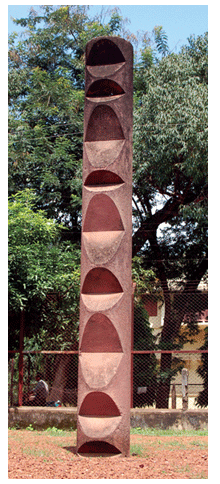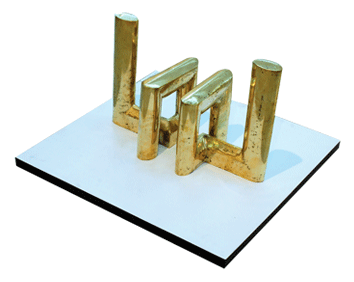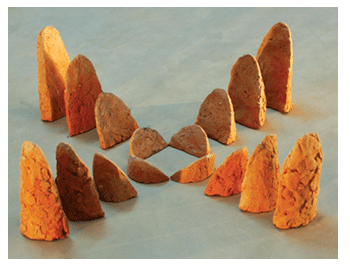- Prelude
- Editorial
- ...Where ever I stumble, let painting lie before me....
- ...Colour guides in its own direction...
- Abstract Art: Popular Myths and History
- Abstract Rhetoric:
- Ram Kumar: A transition from figurative to abstract
- I walk the line
- Exploring a twilight zone
- Articulating the Abstract voice from Madhya Pradesh
- Perception of Abstract in forms
- Confronting Cultures: The Dialectic of Abstraction in Bengal Art
- K.C.S. Paniker and his Words and Symbols
- Dialectics of Abstract Art and Its Indigenous Identity
- Between Ambivalence and Criticism: Why Abstraction?
- Notations and Rhythm in Space: Sushen Ghosh
- Victorian Era: Eclectic Furniture
- Patek Philippe : an overview
- The “Theme Pandals” of Durga Pujo: An Unexplored Discourse
- Musings on Music
- Butterflies in the stomach… still
- Contemporary Art Market Report 2009-10
- Artist Index and Statistics
- Auction Reports
- Recent works of Pavan kumar D. - In the Journey of Learning things
- Narrating “with a pinch of salt” Paintings of K.P.Reji
- Reclaiming an artist of true calibre
- Musings from Chennai
- An Annual Homage..
- Art Events Kolkata: September-October 2010
- Mumbai Art Sighting
- Art Bengaluru
- Unveiling the next in line
- Preview
- In the News
- Sotheby’s : Important Watches Hong Kong
ART news & views
Notations and Rhythm in Space: Sushen Ghosh
Volume: 3 Issue No: 10 Month: 11 Year: 2010
 Way back in 1968; in a review of a solo exhibition held at Academy of Fine Arts, Kolkata, the critic spoke highly of the formal aptitude of a young sculptor. The critic did not fail to notice that for all its figural references it was the modeling done in 'clean, sweeping lines' effectively combining 'rhythm with monumentality' that stole the show. At that point of time, for this twenty-eight years old sculptor Sushen Ghosh, it was only a matter of time to leave the figurative trapping completely and delve into the realm of what is commonly known as 'abstract'.
Way back in 1968; in a review of a solo exhibition held at Academy of Fine Arts, Kolkata, the critic spoke highly of the formal aptitude of a young sculptor. The critic did not fail to notice that for all its figural references it was the modeling done in 'clean, sweeping lines' effectively combining 'rhythm with monumentality' that stole the show. At that point of time, for this twenty-eight years old sculptor Sushen Ghosh, it was only a matter of time to leave the figurative trapping completely and delve into the realm of what is commonly known as 'abstract'.
In 1970 Sushen Ghosh was in London doing Advance Diploma at Goldsmith College of Art. His exposure to a wide range of original art in Tate Gallery of British Museum and other collections and his close proximity with a certain dominant section of modern art that rated the abstract over figuration certainly inspired Sushen to look into the possibilities of pure form deeply than ever before. But, the journey surely began from Santiniketan itself. Encountering the modern art in Europe, Sushen felt, candidly and meaningfully, that Ramkinkar Baij's sculpture would have looked great there. The underlying sense that kindled this reflection was to do with the modern art's continuous claim for the independence of formal values and how Ramkinkar's work could be a fitting partaker in that. No doubt that Sushen was stirred to see the constructivist and minimalist works of Theo Van Doeshurg, Kenneth Martin, Max Bill, Constantin Brancusi, Noam Gabo, Anton Pevsner and others. Ben Nicholson and Barbara Hepworth two of the chief exponents of abstract sculpture in Great Britain during the early 1970s were also around. Through the works of these two artists one could also connect the earlier traditions of Piet Mondrian, Brancusi and Jean Arp. Despite this and with all respect to this direct contact with the grand narrative of the abstract arts of the West, Sushen has something different to say about his genesis in this regard.
With great conviction Sushen attributes his penchant for the formal abstraction to the lessons he received from his mentors at Kala Bhavana where he was a student from 1958 to 1963. Right from the beginning his mentors instilled in him the value and significance of formal principles in art.
In retrospect, the tradition of Santiniketan art has been by and large a figurative one. Abstract art would have been an unlikely pursuit, an anathema in that context. Sushen Ghosh says, 'Compared to other art institutions Kala Bhavana teachers were never keen on imparting the skills of realistic representation but always pointing out the abstract pictorial qualities intrinsic to the language of art in different mediums. Nandalal Bose, for instance, would always speak of 'rhythm' as the guiding principle for art.  For Ramkinkar it was the urgency to exercise artistic freedoms that lead him to recognize the formal principles like 'structure' and 'movement' as the crucial visual tools to achieve that. Benode Behari would highlight the architectonic and tension as two important compositional values in art. In other words, all of them were talking about the abstract values and often placing them above subject-matter and theme.'
For Ramkinkar it was the urgency to exercise artistic freedoms that lead him to recognize the formal principles like 'structure' and 'movement' as the crucial visual tools to achieve that. Benode Behari would highlight the architectonic and tension as two important compositional values in art. In other words, all of them were talking about the abstract values and often placing them above subject-matter and theme.'
In fact Ramkinkar is one lone exception of that time to try his hand at pure abstract sculptures like the 'Speed' and 'Lamp-stand'. Later, Prasanto Roy also has done some paintings reminding us of Gaganendranath Tagore's post-cubist works, but betraying an understanding of painterly values in abstract terms. But these examples can be treated as exceptions considering the larger corpus of Santiniketan art which is still predominantly representational, be it figurative or landscape. 'Despite their engagement with representational images their formal preoccupations are remarkable and a matter of great consequence', remarks Sushen Ghosh. One should not also miss the fact that right at the outset Kala Bhavana pedagogy embraced the craft traditions and functional arts seriously. Hence a consistent design practice in the areas of textile, stage-décor, decorative mural and floor-graphics (alpona) nurtured a sense of the abstract and shaped its broader aesthetic ideas. Therefore, the abstract art of Santiniketan can not be seen as opposed to the figurative. It was there ingrained very conspicuously in the tradition; it was not necessarily an 'idea of the pure brain'.
By renouncing narrative or descriptive references abstract art tend to claim an independent entity. But for Sushen it opens up the possibility of reconnecting art with the various strands of art practices. Pure form also helps him to relate his sculpture with philosophical concepts, architectural constructions, basic design modules, musical patterns and even mathematical configurations. A very acute sense of proportion makes many of his smaller sculptures attain unexpected monumentality. Monumentality in his sculptures is not about largeness but suggests extension into space or into distance, conveying a sense of infinity. More often than not, seemingly simple geometric forms and calculated arrangement of shapes in space serve this idea. Material for Sushen is never an issue but he does bring into the material a kind of finish that is restful yet not dull. The subtleties thus achieved are results of what J. J. Narzary calls 'static-dynamism'; a mathematical order that never falls short to take into account almost imperceptible inflections that create the music. One can see how these abstract permutations and combinations are neatly integrated into the tangible forms of Sushen's sculptures and how musical notations become palpable experiences in a measured space.
a mathematical order that never falls short to take into account almost imperceptible inflections that create the music. One can see how these abstract permutations and combinations are neatly integrated into the tangible forms of Sushen's sculptures and how musical notations become palpable experiences in a measured space.
Sushen's fascination with numbers has become legendary among his students and colleagues. For some it is a bit mysterious but for Sushen it is disarmingly simple. 'Number corresponds to movement, proportion, balance, thrust or tranquility…number is your reference point now as the so called real has been rejected.'
Yet, abstract art has its own special kind of reality. Its presence is felt in the two huge outdoor sculptures in the Kala Bhavana campus. These two large abstract sculptures are made by Sushen Ghose and they do not have anything comparable in the campus. Rests of all are distinctly figurative. But the connectivity, the sense of belonging is unmistakable. As you keep looking and pondering at them you realize that Sushen Ghosh's abstract works emerge from inside the tradition.